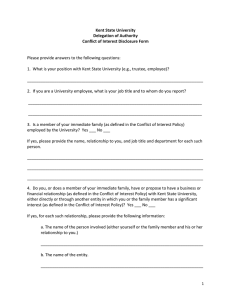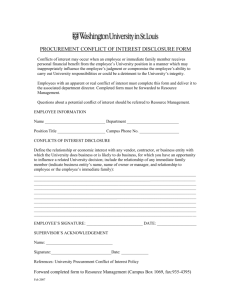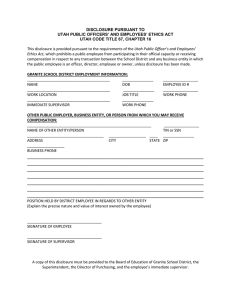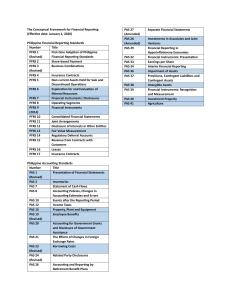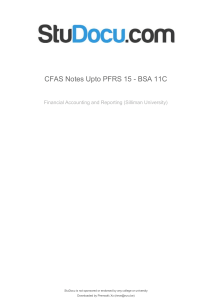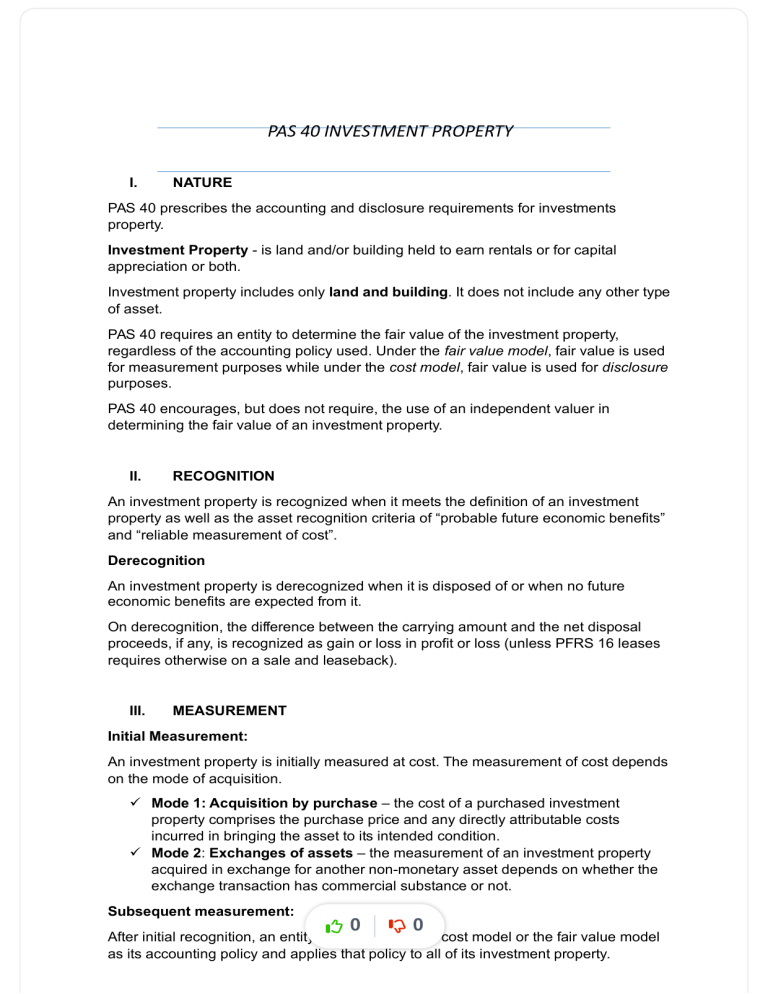
PAS 40 INVESTMENT PROPERTY I. NATURE PAS 40 prescribes the accounting and disclosure requirements for investments property. Investment Property - is land and/or building held to earn rentals or for capital appreciation or both. Investment property includes only land and building. It does not include any other type of asset. PAS 40 requires an entity to determine the fair value of the investment property, regardless of the accounting policy used. Under the fair value model, fair value is used for measurement purposes while under the cost model, fair value is used for disclosure purposes. PAS 40 encourages, but does not require, the use of an independent valuer in determining the fair value of an investment property. II. RECOGNITION An investment property is recognized when it meets the definition of an investment property as well as the asset recognition criteria of “probable future economic benefits” and “reliable measurement of cost”. Derecognition An investment property is derecognized when it is disposed of or when no future economic benefits are expected from it. On derecognition, the difference between the carrying amount and the net disposal proceeds, if any, is recognized as gain or loss in profit or loss (unless PFRS 16 leases requires otherwise on a sale and leaseback). III. MEASUREMENT Initial Measurement: An investment property is initially measured at cost. The measurement of cost depends on the mode of acquisition. Mode 1: Acquisition by purchase – the cost of a purchased investment property comprises the purchase price and any directly attributable costs incurred in bringing the asset to its intended condition. Mode 2: Exchanges of assets – the measurement of an investment property acquired in exchange for another non-monetary asset depends on whether the exchange transaction has commercial substance or not. Subsequent measurement: 0 0 After initial recognition, an entity chooses either the cost model or the fair value model as its accounting policy and applies that policy to all of its investment property. 0 0 Only one model shall be used. Using both models selectively for items of investment property is prohibited. IV. TRANSACTION a. Land held for long-term capital appreciation rather than for short-term in the ordinary course of business. b. Land held for a currently undetermined future use. c. A building owned by the entity (or a right-of-use asset relating to a building held by the entity) and leased out under one or more operating leases. d. A building that is vacant but is held to be leased out under one or more operating leases. e. Property that is being constructed or developed for future use as investment property. V. PRESENTATION A property that is leased by a member of a group to another member (parent or subsidiary) does not qualify as investment property in the consolidated financial statements because, from the group’s perspective, the property is owner-occupied. However, the property is classified as investment property in the lessor/owner’s individual financial statements. VI. DISCLOSURE General disclosure: a. Whether the entity uses the fair value model or the cost model. b. When classification is difficult, the criteria used to distinguish investment property from PPE and inventory. c. The extent to which the fair value of investment property is based on a valuation by an independent valuer. If an independent valuation is not obtained, that fact is disclosed. d. The amounts recognized in profit or loss for rental income and related expenses. e. The existence and amounts of restrictions on investment property. f. Contractual obligations to purchase, construct or develop investment property or for repairs, maintenance or enhancements. Additional disclosures under the fair value model: a. Reconciliation showing increases and decreases in investment property. b. When a valuation obtained for investment property is adjusted to avoid doublecounting of assets or liabilities that are recognized as separate assets and liabilities, the entity discloses a reconciliation between the valuation obtained and the adjusted valuation. c. Disclosure of any investment property whose fair value on initial recognition cannot be reliably measured and hence measured under the cost model using the exception allowed under PAS 40. 0 0

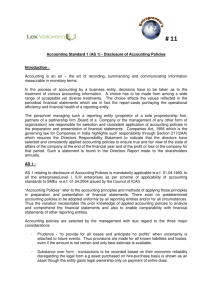
![FORM O-9 Report of valuation of works of art [See rule 8D]](http://s2.studylib.net/store/data/016947428_1-6b57f4ec8e756f54db6fca918305533b-300x300.png)
